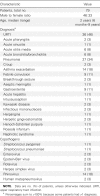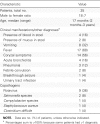Clinical and molecular epidemiology of human bocavirus in respiratory and fecal samples from children in Hong Kong
- PMID: 17763318
- PMCID: PMC7111856
- DOI: 10.1086/521310
Clinical and molecular epidemiology of human bocavirus in respiratory and fecal samples from children in Hong Kong
Abstract
Background: Human bocavirus (HBoV) is a recently discovered parvovirus associated with respiratory tract infections in children. We conducted the first systematic prospective clinical and molecular study using nasopharyngeal aspirates (NPAs) and fecal samples.
Methods: NPAs negative for influenza virus, parainfluenza virus, respiratory syncytial virus, adenovirus, and coronavirus and fecal samples from patients with acute gastroenteritis were included. On the basis of results from a pilot study using 400 NPAs from all age groups, a prospective 12-month study was conducted to detect HBoV in 1,200 NPAs and 1,435 fecal samples from patients <18 years old by polymerase chain reaction. The complete genome sequences of HBoVs from 12 NPAs and 12 fecal samples were determined.
Results: Of the 400 NPAs collected in the pilot study, 20 (5.0%) were found to contain HBoV, all from children <5 years old. In the subsequent prospective study of pediatric patients, HBoV was detected in 83 (6.9%) of 1,200 NPAs. Upper and lower respiratory tract infections were equally common. HBoV was detected in 30 (2.1%) of 1,435 fecal samples. Fever and watery diarrhea were the most common symptoms. The seasonality of HBoV in NPAs and fecal samples was similar. Codetection with other pathogens occurred in 33% and 56% of NPAs and fecal samples, respectively, from patients with HBoV infection. Genomes of HBoVs from NPAs and fecal samples displayed minimal sequence variations.
Conclusions: HBoV was detected in fecal specimens in children with acute gastroenteritis. A single lineage of HBoV was associated with both respiratory tract and enteric infections.
Conflict of interest statement
Potential conflicts of interest: none reported.
Figures





Comment in
-
Human bocavirus: multisystem detection raises questions about infection.J Infect Dis. 2007 Oct 1;196(7):968-70. doi: 10.1086/521311. Epub 2007 Aug 29. J Infect Dis. 2007. PMID: 17763314 Free PMC article. No abstract available.
References
-
- Macfarlane JT, Colville A, Guion A, Macfarlane RM, Rose DH. Prospective study of aetiology and outcome of adult lower-respiratorytract infections in the community. Lancet. 1993;341:511–4. - PubMed
-
- Ruiz M, Ewig S, Marcos MA, et al. Etiology of community-acquired pneumonia: impact of age, comorbidity, and severity. Am J Respir Crit Care Med. 1999;160:397–405. - PubMed
Publication types
MeSH terms
Substances
Associated data
- Actions
- Actions
- Actions
- Actions
- Actions
- Actions
- Actions
- Actions
- Actions
- Actions
- Actions
- Actions
- Actions
- Actions
- Actions
- Actions
- Actions
- Actions
- Actions
- Actions
- Actions
- Actions
- Actions
- Actions
LinkOut - more resources
Full Text Sources
Medical

